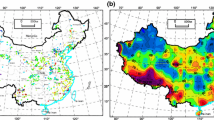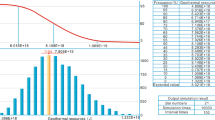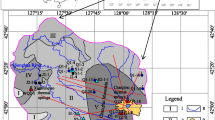Abstract
The geogas field can reflect the deep-seated tectonic constructing information. Geogas method can be applied to the exploration of deep geothermal resources. In this paper, based on the advanced geogas model of metal ore, a set of simulation model of geogas transportation for hot spring is built. In the model, hot spring water collected from Wuning, JiangXi province, China is used to simulate hot spring reservoir, and the hot air flow formed by electric hot plate is used to simulate rising geogas flow. The transporting materials from hot spring reservoir are sampled in 20, 40, 60, 80 and 100 d respectively. More than 30 elements in these samples are determined with ICP-MS. The experimental results confirm that many elements in hot spring can be transferred out by geogas flow, transportation rate and transportation ratio of different elements is of obvious differences. The migratory activity of most elements in hot spring is greater than that in concealed ore body, thus the transportation amount of the element is easily recognizable. The elements with high transportation ratio and high concentration, including Cd, Cu, Pb, Sc, Y, Zn, are most helpful to indicate towards hot springs, the result provides reference to application of geogas survey on geothermal resource exploration.




Similar content being viewed by others
REFERENCES
T. Akagi, “Erratum to “Rare earth element (REE)–silicic acid complexes in seawater to explain the incorporation of REEs in opal and the “leftover” REEs in surface water: new interpretation of dissolved REE distribution profiles” Geochim. Cosmochim. Acta 113, 174–192 (2013).
A. M. Wamalwa, L. F. Serpa, and D. I. Doser, “Investigations of ground water flow associated with the Saratoga warm springs and the Tecopa Hot Springs near Death Valley, California, using magnetic and conductivity methods,” Tectonophysics 502, 267–275 (2011).
S. B. Bortnikova, G. M. Gavrilenko, and E. P. Bessonova, “The hydrogeochemistry of thermal springs on Mutnovskii Volcano, southern Kamchatka,” J. Volcanol. Seismol. 3 (6), 388–404 (2009).
E. M. Cameron, S. M. Hamilton, M. I. Leybourne, E. M. Hall, and M. B. McClenaghan, “Finding deeply buried deposits using geochemistry,” Explor., Environ., Anal. 4, 7–32 (2004).
Ding Lei, Song Saojun, and Guan Jian, “Application and prospect of geothermal resources exploration method JiLin Geology,” 23 (4), 113–117 2004 [in Chinese].
Hu Bo and Zhou Sichun, „Experiment and significance of geogas prospecting in tunnel for exploration of concealed polymetallic ore deposits,” The International Symposium on Deep Exploration into the Lithosphere 2011 Beijing, China (Beijinng, 2011), pp. 119–121.
Krister Kristiansson and Lennart Malmqvist, “Evidence for nondiffusive transport of 22286 Rn in the ground and a new physical model for the transport,” Geophysics 47 (10), 1444–1452 (1982).
Lennart Malmqvist and Krister Kristiansson, “Experimental evidence for an ascending microflow of geogas in the ground,” Earth Planet. Sci. Lett. 70, 407–416 (1984).
Liu Jin King, Yu Ming Fang, and Ueng Shiun Jenq, “A structure–controlled model for hot spring exploration in Taiwan by remote sensing,” Geosci. J. 4, 323–325 2003.
M. Metwaly, G. El-Qady, and U. Massoud, “Integrated geoelectrical survey for groundwater and shallow subsurface evaluation: case study at Siliyin spring, El–Fayoum, Egypt,” Int. J. Earth Sci. 99 (6), 1427–1436 (2010).
Mohamed Abdel Zahera, Hakim Saibib, and Jun Nishijima, “Exploration and assessment of the geothermal resources in the Hammam Faraun hot spring, Sinai Peninsula, Egypt,” J. Asian Earth Sci. 45 (2), 256–267 (2012).
R. K. Majumdar, N. Majumdar, and A. L. Mukherjee, “Geoelectric investigations in Bakreswar geothermal area, West Bengal, India,” J. Appl. Geophys. 45, 187–202 (2000).
K. Richards, A. Revil, and A. Jardani, “Pattern of shallow ground water flow at Mount Princeton Hot Springs, Colorado, using geoelectrical methods,” J. Volcanol. Geotherm. Res. 198 (1), 217–232 (2010).
Shi Changyi, Zhu Bingqiu, and Zhu Lixin, “Research on seismic structure of geothermal system by gas geochemical survey (Chinese),” Geophys. Geochem. Explor. 16 (5), 377–384 (1992).
Tetsuya Sanada, Nobuki Takamatsub, Yuzo Yoshiike, “Geochemical interpretation of long–term variations in rare earth element concentrations in acidic hot spring waters from the Tamagawa geothermal area, Japan,” Geothermics 35 (2), 141–155 (2006).
Tong Chunhan, Li Juchu, Ge Liangquan, “A new form of elemental migration and its geochemical environmental effects,” J. Chengdu Univ. Technol. 29 (5), 567–570 (2002).
X. Wei, J. Cao, and R. F. Holub, “TEM study of geogas–transported nanoparticles from the Fankou lead–zinc deposit, Guangdong Province, South China,” J. Geochem. Explor. 128, 124–135 (2013).
Z. Wenbin and Z. Weimin, “Gas isotopes and geochemistry of hot springs in Hengjing, Jiangxi Province, Sci. China, Ser E. 44 (S1), 151–154 (2001).
Wang, M. Q. Y. Y. Gao, and Y. H. Liu, “Progress in the collection of Geogas in China,” Geochem: Explor., Environ., Anal. 8, 183–190 (2008).
Wang Xueqiu, and Ye Rong, “Findings of nanoscale metal particles: evidence for deep–penetrating geochemistry,” Acta Geosci. Sinica. 32 (1), 7–12 (2011).
Y. Xu, M. Q. Wang, Y. Y. Gao, and H. Zhang, Tracing the source of ‘metals in soil gas’. Geochem.: Explor., Environ., Anal. 15 (1), 3–11 (2015).
J. Zhang, Z. W. Xu, H. Y. Li, X. N. Yang, X. C. Lu, and H. C. Li, “The mineralization geochemistry of the Wangjiazhuang copper deposit in Zouping County, Shandong Province,” Geogr. 54, 466–476 (2008).
Zhang Jinhua and Wei Wei, “Distribution characteristics and utilization of geothermal resources in China.” China Land Resources Econom. 8, 23–24 (2011).
Zhou Sichun, Liu Xiaohui, and Hu Bo, “Geological significance of ground gas field information (Chinese),” Geophys. Geochem. Explor. 36 (6), 1044–1049 (2012).
Zhou Sichun, Liu Xiaohui, and Tong Chunhan, “Study on ground gas measurement technology and its application in concealed ore exploration (Chinese),” Acta Geol. Sinica. 88 (4), 736–754 2014.
Zhou Sichun, Liu Xiaohui, and Tong Chunhan, “Elemental migration law in ground gas model,” Geophys. Geochem. Explor. 36 (6), 1050–1054 (2012).
Zhou Sichun, Liu Xiaohui, and Hu Bo, Geogas and Radioactivity Detection Techniques and Experiments for Deep Metallogenic Information in the Nanling Ore District (Atomic Energy Press, 2015).
ACKNOWLEDGMENTS
We express our sincere gratitude to Pro. Ge Liangquan for advice and assistance of our research work, we also would like to thank to the mass spectrometer analysis laboratory in CDUT for assistance in data analysis, and students in our research group for the geogas sample collection. We finally thank the National Natural Science Foundation of China (41274131) for financial support.
Author information
Authors and Affiliations
Corresponding author
Rights and permissions
About this article
Cite this article
Bo Hu, Li, F., Liu, X. et al. Simulated Experiment of the Geothermal Resources Exploration in Tangli Hot Spring, Wuning, Jiangxi Province, China. Geochem. Int. 58, 729–736 (2020). https://doi.org/10.1134/S0016702920060038
Received:
Revised:
Accepted:
Published:
Issue Date:
DOI: https://doi.org/10.1134/S0016702920060038




